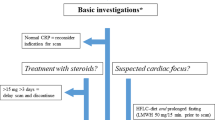Summary
Because of its technical capabilities, its rapidity and its non-invasive nature, computed tomography (CT) has given a new scope to neurological diagnosis and to the understanding of various aspects of neurological science. The availability of this test is determined by the patient load. If precise clinical indications are not considered, patients requiring CT the most may be denied immediate examination because less urgent cases may be occupying valuable diagnostic time. Moreover, the test is relatively expensive for the individual patient and for the community; this presents another facet of its use that should be taken into account.
The technical limitations and clinical priorities to be considered when a physician is entertaining this test for a patient have been outlined. The indications have been divided into absolute and relative, according to the degree of clinical urgency. As a result, a priority guideline for diagnostic CT has been provided.
Similar content being viewed by others
References
Ambrose, J., Computerized transverse axial scanning (tomography): Part 2. Clinical Application. Brit. J. of Radiol.46 (1973), 1023–1047.
Baker, H. L.et al., Early experience with the EMI scanner for study of the brain. Radiology116 (1975), 327–333.
David, D. O., Pressman, B. D., Computerized tomography of the brain. Radiol. Clinic of NA12 (1974), 297–313.
Scott, W. R.et al., Computerized axial tomography of intracerebral and intraventricular hemorrhage. Radiology112 (1974), 73–80.
Naidich, T. P., Chase, N. E., Use of computerized axial tomography in evaluation of cerebrovascular disease. Current Concepts of Cerebrovascular Disease.10 (1975), 19–24.
Pressman, B. D., Gilbert, G. E., Davis, D. O., Computerized transverse tomography of vascular lesions of the brain, Part II: Aneurysms. Amer. J. Roentgenol.124 (1975), 215–219.
Pressman, B. D., Kirkwood, Jr., Davis, D. O., Computerized transverse tomography of vascular lesions of the brain, Part I: Arteriovenous malformations. Amer. J. Roentgenol.124 (1975), 208–213.
Paxton, R., Ambrose, J., The EMI scanner. A brief review of the first 650 patients. Brit. J. of Radiol.47 (1974), 530–565.
New, P.et al., Computerized axial tomography with EMI scanner. Radiol.110 (1974), 109–123.
New, P.et al., Computerized tomography with EMI scanner. Radiol.114 (1975), 75–87.
Alper, M. G.et al., Computerized axial tomography. Trans. Amer. Acad. Ophtal. Oto-laryng.79 (1975), OP 150-OP 165.
Huckman, M. S., Fox, J., Topel, J., The validity of criteria for the evaluation of cerebral atrophy by computed tomography. Radiol.116 (1975), 85–92.
Author information
Authors and Affiliations
Additional information
Recipient of USDHS Teacher-Investigator Award 5KO 7NS 11061-04.
Rights and permissions
About this article
Cite this article
James, H.E., Zimmerman, R., Bilaniuk, L. et al. Priorities and indications of computed tomography in clinical practice. Acta neurochir 36, 1–7 (1977). https://doi.org/10.1007/BF01405982
Issue Date:
DOI: https://doi.org/10.1007/BF01405982




